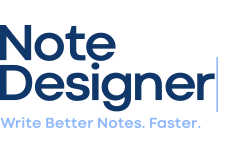Comparing Types of Progress Notes: SOAP, BIRP, DAP and BASIC notes

There are several different approaches that mental health professionals can use to document their clinical work. Three common types of therapy progress notes are SOAP, BIRP, and DAP. Note Designer has also created an additional note type that many clinicians find helpful referred to as the Basic Note. All four note types are available in Note Designer software where the therapist can select the phrases and descriptors they need to populate their note and create professionally narrated notes. While all four types of notes serve a similar purpose – to document a client’s progress in therapy – each approach has its own unique structure and focus. In this post, I compare and contrast these four therapy note types to help you understand which approach might best suit your particular clinical need.
SOAP Notes
SOAP notes are perhaps the most widely used type of therapy notes. The SOAP format stands for Subjective, Objective, Assessment, and Plan. Here’s a quick breakdown of what each section of a SOAP note entails:
- Subjective: This section includes information about the client’s subjective experience, including any reported symptoms, emotions, or concerns they may have.
- Objective: In this section, the therapist documents any observable, measurable information about the client, such physical appearance, observable symptoms, or other verifiable data.
- Assessment: This section is where the therapist provides their clinical perspective and synthesis of the client’s progress as derived from what was reported by the client and from what was observed during the session (using the Subjective and Objective data already documented).
- Plan: The final section of a SOAP note outlines the therapist’s plan for treatment going forward, including any interventions used or planned and any changes to the client’s treatment plan or goals.
SOAP notes are highly structured and provide a clear overview of a client’s progress in therapy. They’re often used in medical settings and are helpful for communicating with other healthcare professionals in a concise manner about a client’s progress and treatment plan.
BIRP Notes
BIRP notes are another type of therapy note that many therapists use. The BIRP format stands for Behavior, Intervention, Response, and Plan. Here’s a breakdown of what each section of a BIRP note entails:
- Behavior: This section documents the client’s presentation and behavior during the therapy session, including any observable and reported actions, emotions, or communications. Essentially, we include here what the client brought to the session.
- Intervention: In this section, the therapist documents everything that happened during the session as part of the treatment. This would include the main themes explored during the session as well as the specific interventions used to address the client’s concerns and difficulties.
- Response: The response section documents how the client responded to the interventions used and the treatment more generally.
- Plan: The final section outlines the therapist’s plan for future sessions, including any changes to the client’s treatment plan or goals.
BIRP notes are similar to SOAP notes in that they are highly structured and provide a clear overview of a client’s progress in therapy. BIRP notes tend to be somewhat more focused on documenting the interventions used during therapy sessions, rather than a concise overview of a client’s progress.
DAP Notes
DAP notes are a third type of therapy note that some therapists use. The DAP format stands for Data, Assessment, and Plan. Here’s a breakdown of what each section of a DAP note entails:
- Data: This section documents any observable, measurable data about the client, such as their behavior, mood, or symptoms.
- Assessment: In this section, the therapist provides their professional assessment of the client’s progress, including any diagnoses and significant developments.
- Plan: The final section outlines the therapist’s plan for future sessions, including any changes to the client’s treatment plan or goals.
DAP notes are somewhat less structured than SOAP or BIRP notes and provide a more narrative account of a client’s progress in therapy. They’re often used in community mental health settings and are helpful for documenting a client’s progress in a more holistic way.
Basic Notes
Basic Notes were developed by Note Designer to provide another solution for organizing progress notes. The Basic format follows the chronological unfolding of what takes place during a session over time. The sections of the Basic note are Presentation, State, Assessment, Themes, Treatment and Progress (PSATTP).
- Presentation: This section documents the location and format of the session as well as the clinically relevant aspects of the client’s appearance.
- State: Here we document the client’s emotional state, behaviors, mental state, overall level of functioning and any relevant biopsychosocial factors.
- Assessment: This section is for the documentation of any assessments administered (e.g., mood measures, stress inventories etc.) and their relevant results.
- Themes: Here we note the various themes or topics that were discussed and explored during the session.
- Treatment: In this section the therapist documents their interventions or anything they did or said to further the treatment as well as the client’s response to these interventions.
- Progress: The final section specifies any significant developments, outstanding concerns, modifications to the treatment plan, goals or objectives, as well as any assigned therapeutic tasks or homework.
Basic notes are somewhat more structured than SOAP, BIRP, and DAP notes and follow the chronological experience of the session as it unfolds from beginning to middle to end. They may be most helpful for therapists in private practice and for those who prefer a more detailed account of their clinical work as it is experienced naturally over time.
Conclusion
There are many ways in which clinicians may choose to organize their progress notes. Each approach has its own unique structure and focus. SOAP notes are highly structured and provide a clear overview of a client’s progress over time. BIRP notes are similar to SOAP notes but are more focused on documenting specific interventions used during therapy sessions, while DAP notes tend to present client progress in a more narrative based style. The Basic note developed by Note Designer is a highly structured note type that emphasizes the experience of the session as it unfolds over time. Which approach we prefer likely depends on the type of psychotherapy we conduct (e.g., open-ended and experiential versus time-limited and problem focused), the setting in which we work (private practice versus hospital based), the regulations of our particular profession (e.g., psychologist versus psychiatrist versus counsellor etc.), the requirements of any third-party payers (e.g., insurance companies. Medicare, Medicaid), and perhaps also our own personal style (scientific and parsimonious, artistic and literary, pragmatic and practical, etc.).
Comparing and contrasting the different notes it seems that the SOAP note format may be particularly suited for more medically based or psychiatric treatments where the distinctions between objective and subjective are perhaps germane or even necessary (i.e., what the patient reports versus the patient’s blood work, medication status, or physical exam results). With that said, distinguishing between what is objective and subjective information in an ongoing psychotherapeutic process is not always readily apparent nor, it could be argued, is it necessarily the best way to characterize what has transpired in a session (e.g., when trying to describe interactions between the therapist-subject and the client-subject the distinction may clearly breakdown). Furthermore, some theoretical traditions do not espouse clear distinctions between subject and object on philosophical grounds (e.g., existential approaches and some psychoanalytically based approaches). In light of all of this, it seems that the BIRP, DAP, and Basic note types may be most fitting for the documentation of psychotherapy in all of its complexity whereas the SOAP note format may be well suited when the concise documentation of the pragmatic aspects of a therapy session are most germane (such as for insurance purposes).
No matter what type of note format you end up choosing—what really matters is that your notes are done!
 . -Patricia from Note Designer-
. -Patricia from Note Designer-

